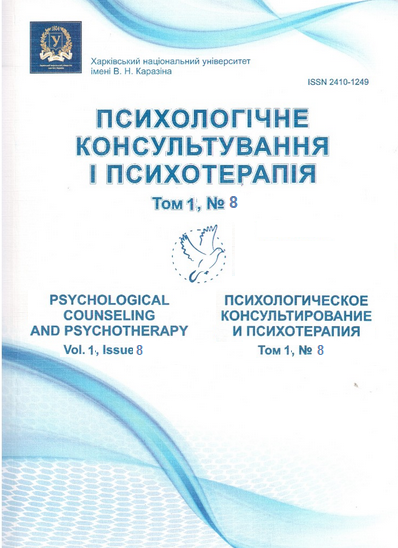Peculiarities of psychotherapeutic work with traumatic emotional experience of combatants
Abstract
This article introduces the features of psychotherapeutic work with the traumatic emotional experience among combatants. The applicability of this issue has sharply increased over the past 3-4 years, primarily due to the events in eastern Ukraine, namely, the Antiterrorist Operation (ATO), which determined the growth of combatants with different features of emotional trauma. The specific conditions for the combatants, the peculiarities of communication with the executives, subordinates and comrades, the features of the traumatic emotional experience, the importance of working with emotional structures, pointed out by O.S. Kocharian and his students in numerous researches, make it necessary to develop a psychotherapeutic strategy for working with combatants. The article considers the possibility of using client-centered psychotherapy as a core component of therapy, complemented by elements of cognitive psychotherapy, psychotherapy by A.F. Yermoshin, and the direction proposed by David Berceli, namely TRE - Trauma & Tension Releasing Exercises, which in general give the opportunity to avoid possible destructive specificity of interaction with clients-combatants-men. A possible specificity of therapeutic work with women is not considered. Characteristics of the emotional traumatic experience among combatants, based on a concrete example of therapeutic practice is: fragmentation of memories, "gluing of emotions and feelings", loss of connection between meaning and emotion, dissociation from certain emotions (fear, aversion, crying), the generation of "blocked" emotions, alexithymia and awareness of emotions only at the level of sensations, rigidity of the emotional sphere, high level of work of such protective mechanisms as psychological displacement, negation, isolation of the affection.
Downloads
References
Бек Аарон // Психотерапевтическая энциклопедия / Под. ред. Б.Д. Карвасарского. – Изд. 2-е, доп. И перераб.. – Спб.: Питер, 2000. – С. 81-82.
Бермант-Полякова О.В. Посттравма: диагностика и те- рапия / О.В. Бермант-Полякова. – СПб. : Речь, 2006. – 248 с.
Ермошин А.Ф. Вещи в теле: Психотерапевтический метод работи с ощущениями / А. Ф. Ермошин – М.: Независимая фирма “Класс”, 1999. – 320 с.
Кочарян А.С. Переживание как мишень клиент-центрированной психотерапии / А.С. Кочарян // Психологічне консультування і психотерапія. – 2014 – випуск 1-2. – С. 24-36.
Психотерапия как невербальная практика: коллективная монография / [А. С. Кочарян, И. А. Кочарян, М. Е. Жидко, Н. Н. Терещенко, А. М. Лисеная, Л.П. Рогулева, С.А. Кочарян]; под ред. д. психол. н., проф. А.С. Кочаряна. - Х.: ХНУ имени В.Н. Каразина, 2014. – 260 с.
Роджерс К. Взгляд на психотерапию. Становление человека: Пер. с англ. / Общ. ред. и предисл. Исениной Е.И.. – М.: Издательская группа «Прогресс», «Универс», 1994. – 480 с.
Ромек В.Г. Психологическая помощь в кризисных ситуаци- ях / В.Г. Ромек, В.А. Конторович, Е.И. Крукович. – СПб. : Речь, 2007. – 256 с.
David Berceli: "The Revolutionary Trauma Release Process (Transcend Your Toughest Times)" - Namaste Publishing, Vancouver, Canada 2009.
Citations
Structural Features for Cognitive Representations of Traumatic Emotional Experience Among Demobilized Combatants in Ukraine with Post-Stress Psychological Disadaptation
(2019) Psychological Counseling and Psychotherapy
Crossref








